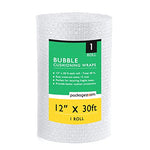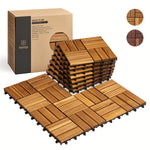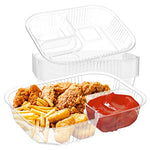You have no items in your shopping cart.
Changing a trash bag is an important yet simple task that we need to do frequently, whether at home or in a commercial setting.
The process might seem straightforward, but doing it wrong can lead to a mess that nobody wants to deal with.
In this comprehensive guide, we will cover all the steps involved in changing a trash bag in detail to ensure that the process is as easy and efficient as possible.
Step 1: Gather the Necessary Supplies
Before you begin changing the trash bag, make sure you have all the necessary supplies. You will need a new trash bag, gloves (optional), and disinfectant spray or wipes (optional). If you're in a commercial or industrial setting, you might need a larger trash can, a dolly, and a broom and dustpan.
It's important to note that not all trash bags are the same. Depending on the type of trash you're disposing of, you may need a different type of bag. For instance, if you're dealing with food waste or wet trash, you'll need a thicker and more durable bag to prevent leaks. Always make sure that you have the right type and size of trash bag before you start.
Step 2: Empty the Trash Can
The first step in changing a trash bag is to empty the trash can. If there's any trash left in the bag, remove it and dispose of it properly. If the trash is wet or sticky, use a broom and dustpan to sweep it out of the trash can.
If you're dealing with a large amount of trash or heavy items, you may need to use a dolly to move the trash can to a more manageable location. If you have a lot of heavy trash to dispose of, it's always best to do it in smaller batches to avoid straining your back or causing other injuries.
Step 3: Prepare the New Trash Bag
Once the trash can is empty, it's time to prepare the new trash bag. Take the new trash bag out of the box and unfold it. Make sure the bag is the right size for the trash can. If it's too small, it won't fit properly, and if it's too big, it will be difficult to tie.
Open the bag and place it inside the trash can, making sure the edges of the bag overlap the top of the can evenly. If the trash can has a built-in bag holder, make sure the bag is properly secured to the holder to prevent it from slipping.
- Pro tip: To make it easier to tie the bag later, fold the top edges of the bag over the rim of the trash can. This will create a cuff that you can use to hold onto when you're ready to tie the bag.
Step 4: Secure the Bag
After placing the new trash bag in the trash can, it's time to secure it. Grasp the edges of the trash bag and pull them up and over the lip of the trash can. Make sure the bag is pulled tight, so there's no slack in the bag, which could lead to the bag ripping or tearing when the trash is placed inside.
If the trash can has a built-in bag holder, secure the bag to the holder to prevent it from slipping. If the trash can does not have a bag holder, you can use a rubber band or bungee cord to keep the bag in place. This will help prevent the bag from slipping and causing a mess.
Step 5: Replace the Lid
After securing the new trash bag, replace the lid on the trash can. This step is essential to keep any odors from escaping and keep pests out of the trash can. If the trash can doesn't have a lid, consider purchasing one to keep the area clean and odor-free.
If you're in a commercial setting, make sure that the lid is properly labeled for recycling or non-recycling trash. Clear labeling will help prevent confusion and ensure that the proper waste is being disposed of in the right container.
Step 6: Dispose of the Old Trash Bag
Now that the new trash bag is in place and the lid is secure, it's time to dispose of the old trash bag. If the trash bag is not too heavy, tie it securely and take it directly to the dumpster or the designated waste disposal area.
If the trash bag is too heavy, you may need to divide it into smaller, more manageable bags to avoid straining your back or causing other injuries. Always follow proper lifting techniques, such as lifting with your legs and not your back
Step 7: Clean the Trash Can
After disposing of the old trash bag, take a moment to clean the inside of the trash can. Using disinfectant spray or wipes, clean the inside of the can thoroughly to remove any residue or unpleasant odors.
If the trash can has a particularly strong odor, consider using a deodorizing spray to freshen it up. This step is particularly important in commercial settings where multiple people may use the same trash can throughout the day.
Step 8: Store the Extra Trash Bags
If you're using a larger trash can, it's a good idea to keep extra trash bags nearby for easy replacement. Store the extra trash bags in a nearby cabinet or drawer, making sure they are easily accessible when you need them.
Organizing the extra trash bags will also help prevent clutter and make it easier to find the right bag size when you need it. Consider keeping different types of bags for different types of waste to make the process even more efficient.
Step 9: Practice Safe Disposal Methods
Proper disposal of waste is essential for maintaining a clean and healthy environment. In addition to following the steps above, it's important to follow safe disposal methods to minimize the impact on the environment.
Recycling is one of the most effective ways to reduce waste and protect the environment. Always separate recyclable materials from non-recyclable materials and dispose of them in the appropriate container.
Additionally, consider composting food waste to reduce the amount of organic waste that ends up in landfills. Composting is a simple process that turns food scraps into nutrient-rich soil that can be used for gardening or farming.
Step 10: Safety Tips
Changing a trash bag may seem like a simple task, but it's important to take safety precautions to avoid injuries. Here are some tips to keep in mind:
- Always wear gloves when handling trash to protect your hands from germs and bacteria.
- Lift heavy trash bags with your legs and not your back to avoid straining your back muscles.
- When lifting a heavy bag, ask for help from a coworker or family member.
If you're disposing of hazardous materials, such as broken glass or chemicals, use caution and follow proper disposal procedures.
Common Mistakes to Avoid When Changing a Trash Bag
In addition to the steps outlined in this guide, there are some common mistakes that people make when changing a trash bag.
By avoiding these mistakes, you can make the process even more efficient and prevent unnecessary messes or injuries.
Here are some mistakes to watch out for:
· Overstuffing the Trash Bag
One of the most common mistakes when changing a trash bag is overstuffing it. When the bag is too full, it can tear or break, causing a mess and making it difficult to replace the bag.
To avoid this mistake, make sure to only fill the bag about 2/3 full, leaving some space at the top for easy tying and removal.
· Not Securing the Bag Properly
Another common mistake is not securing the trash bag properly. If the bag is not tied or tucked in securely, it can slip out of place or even fall into the trash can, making it difficult to remove and replace.
To avoid this mistake, make sure to tie the bag tightly and tuck it in around the edges of the trash can.
· Using the Wrong Bag Size
Using the wrong bag size is another common mistake that can make changing a trash bag more difficult. If the bag is too small, it may not fit securely in the trash can, leading to spills and messes.
If the bag is too large, it may be difficult to tie or remove. To avoid this mistake, make sure to choose the right size bag for your trash can and the amount of waste you typically generate.
· Forgetting to Clean the Trash Can
Forgetting to clean the trash can after removing the old bag is another common mistake. If the can is not cleaned regularly, it can develop an unpleasant odor or even attract pests.
To avoid this mistake, make sure to clean the inside of the trash can with disinfectant spray or wipes before replacing the bag.
· Ignoring Safety Precautions
Ignoring safety precautions when changing a trash bag is a mistake that can lead to injuries. It's important to wear gloves, use proper lifting techniques, and ask for help if the bag is too heavy.
If you're disposing of hazardous materials, make sure to follow proper disposal procedures to avoid accidents.
By avoiding these common mistakes, you can make changing a trash bag even easier and more efficient. Remember to only fill the bag about 2/3 full, secure the bag properly, choose the right size bag, clean the trash can regularly, and follow safety precautions.
By doing so, you can help maintain a clean and healthy environment while also preventing unnecessary messes or injuries.
Tips for Making Trash Bag Changing Easier and More Efficient
In addition to avoiding common mistakes, there are some tips you can follow to make changing a trash bag even easier and more efficient.
These tips can help you save time and effort while also promoting safe and responsible waste disposal.
Here are some tips to consider:
· Use a Trash Can with a Removable Liner
Using a trash can with a removable liner can make changing a trash bag much easier. Simply lift out the liner, tie the bag, and replace the liner in the trash can. This can help you avoid the hassle of having to pull a full bag out of the can.
· Keep Spare Bags in a Convenient Location
Keeping spare bags in a convenient location can help you avoid the frustration of running out of bags or having to search for them.
Consider storing bags in a nearby cabinet or drawer, or even keeping a roll of bags in the bottom of the trash can itself.
· Use a Bag Dispenser
Using a bag dispenser can also make changing a trash bag easier and more efficient. A dispenser can hold a roll of bags and dispense them one at a time, making it easy to grab a new bag and go.
Some dispensers even come with built-in clips that can attach to the side of a trash can for easy access.
Eco-Friendly Alternatives to Traditional Trash Bags
While traditional trash bags are convenient, they can also have a negative impact on the environment. If you're looking for a more eco-friendly option, there are several alternatives to consider. Here are a few options:
- Compostable Trash Bags: Compostable trash bags are made from materials that can be broken down in a compost pile or facility. They can be a good option for those who compost their food waste and want to reduce the amount of plastic going into landfills.
- Reusable Cloth Bags: Reusable cloth bags can be a great alternative to traditional trash bags. They can be washed and reused many times, reducing the amount of waste generated. However, they may not be suitable for all types of waste and may require more frequent washing.
- Recycled Plastic Trash Bags: Recycled plastic trash bags are made from recycled materials and can help reduce the amount of new plastic produced. However, it's important to make sure that the bags are actually made from recycled materials and not just labeled as "recyclable".
Conclusion
Changing a trash bag may seem like a simple task, but doing it properly can make a big difference in maintaining a clean and healthy environment.
By following the steps outlined in this guide, you can ensure that the process is easy and efficient, while also promoting safe and responsible waste disposal.
Remember to always practice proper lifting techniques and follow safety precautions to avoid injuries.
By working together to reduce waste and promote a cleaner environment, we can all make a positive impact on our environment.







